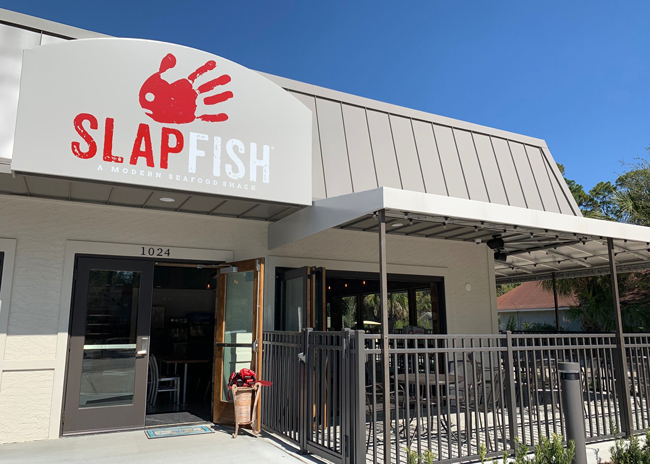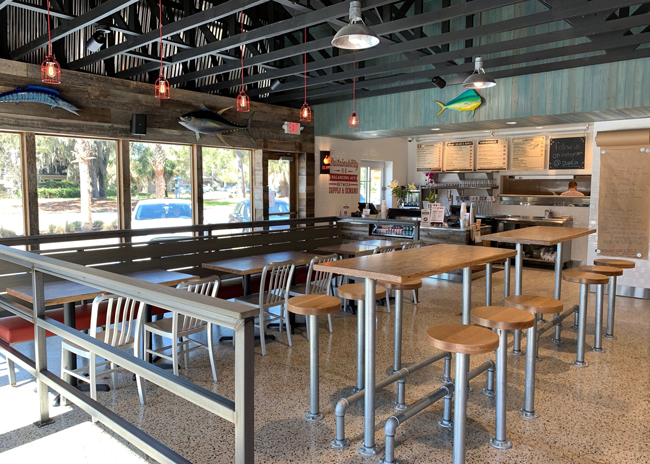Slapfish’s approach to growth gave the 26-store chain a slight advantage when the pandemic hit. Instead of having a set footprint, the chain’s portfolio has grown through every kind of venue, from delivery/take-away style restaurants for food halls and event venues to an operation soon to open that could go flex-casual: fast casual at lunch and full service with a full bar for dinner.
 That flexibility put Slapfish ahead of the curve when it came to adjusting to operating changes as a result of shelter-at-home orders. Miniature versions of its concept already operational serve the chain’s basis for opening additional carryout and delivery-only restaurants if the times call for them.
That flexibility put Slapfish ahead of the curve when it came to adjusting to operating changes as a result of shelter-at-home orders. Miniature versions of its concept already operational serve the chain’s basis for opening additional carryout and delivery-only restaurants if the times call for them.
Andrew Gruel, CEO and founder of Slapfish Restaurant Group, offers this key piece of advice to operators considering their own such restaurant: Keep it simple. “Keep the SKUs low so you can have some cross utilization on products but still have diversity in the menu,” he says. “Focus on labor so you are maximizing your units of labor, so people are not on top of each other. Do a couple of things really well as opposed to trying to be the world to everybody.”
New Kitchen Considerations
Even with experience in dine-in free environments, Slapfish is considering operational changes in response to COVID-19. Changes include the introduction of family meals and possibly new packaging that offers an elevated appearance and helps maintain the quality of delivered food, a persistent challenge for seafood, Gruel says.
The adjustments Slapfish is considering go even further, though. With social distancing now a priority for everyone, the chain is looking at building social distancing into its menu and kitchen operations. Under consideration is the addition of a fast cooking oven or possibly a combi oven that can allow a single employee to produce high volumes of items like sandwiches, paninis and preset dishes in a short amount of time.
When and if Slapfish designs new restaurants with dining rooms, those will likely change as well, Gruel says. “The new model is going to be very cognizant of social distancing, making sure the flow of traffic throughout our locations, if they are dine-in, is going to be easily adaptable so that we can social distance.”
Sustainability Ultimately Drives Slapfish
 The real story behind Slapfish continues to be its dedication to seafood sustainability, which ultimately dates back to 2009 when Gruel took a job with the Aquarium of the Pacific in Long Beach, Calif. With training as a chef and in food marketing, he was a perfect fit to lead a program dedicated to advancing sustainable seafood consumption.
The real story behind Slapfish continues to be its dedication to seafood sustainability, which ultimately dates back to 2009 when Gruel took a job with the Aquarium of the Pacific in Long Beach, Calif. With training as a chef and in food marketing, he was a perfect fit to lead a program dedicated to advancing sustainable seafood consumption.
When the program’s grant ended, he’d learned so much that he developed a foodservice concept around seafood. First came the food truck in 2011, followed by a fast-casual brick-and-mortar restaurant in 2012. By 2013, Slapfish began franchising, growing to 26 locations in 10 states from coast to coast. Today, the chain has 26 locations in 10 states, with about three quarters of those owned by franchisees.
“The heart of our brand is focused around sustainable well-managed seafood,” says Gruel. Working directly with fisherman and sustainable seafood farmers, the chain, “make[s] sure we are serving seafood that is in high supply and doesn't harm the surrounding ecosystem when it is fished. We constantly change our menu based upon availability of seafood.”
One of Slapfish’s advantages, Gruel notes, is that there just isn’t much competition for the seafood dollar in the fast-casual segment. For the most part, seafood is a white tablecloth option or fried fast food.
Slapfish, takes another route, offering fish dishes that are “fun, whimsical and affordable.” Its menu includes items like fish tacos, lobster grilled cheese, shrimp burritos and salads topped with grilled fish or shrimp, all served in a relaxed environment.
The quality of its food and relative lack of competition mean that Slapfish serves as a destination for many customers, Gruel adds. As a result, the chain can open in real estate that is not as prime as other spots but can still draw a crowd. The result is lower rent and overall stronger unit economics.



